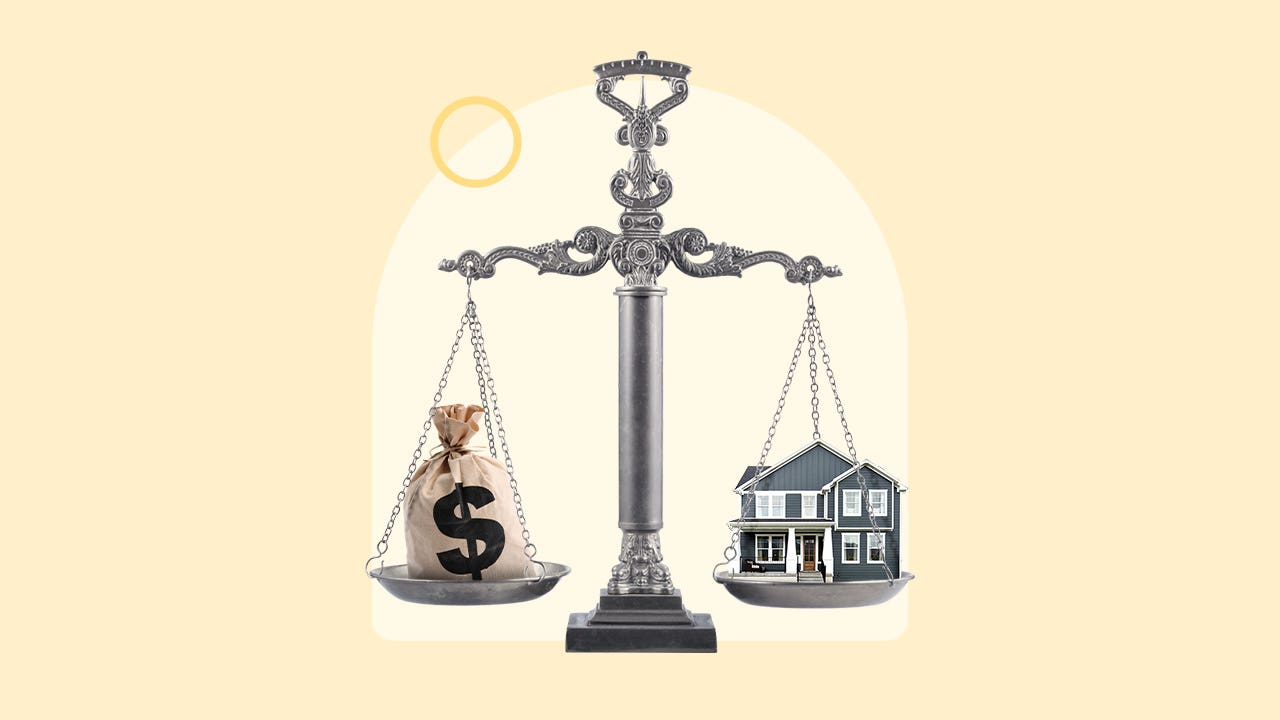What is a loan-to-value ratio?

The Bankrate promise
At Bankrate we strive to help you make smarter financial decisions. While we adhere to strict , this post may contain references to products from our partners. Here's an explanation for .
Key takeaways
- Your loan-to-value (LTV) ratio is the principal of your mortgage loan divided by the value of the property you’re buying, usually expressed as a percentage.
- A lower LTV ratio can help you get a lower interest rate on your mortgage.
- Lenders set a maximum LTV ratio for the home loans they issue.
If you’re applying for a mortgage, you have plenty of numbers swirling in your brain: interest rates, closing costs, your debt-to-income ratio and more. One of the key numbers to add to the mix is the loan-to-value ratio, or LTV ratio. This ratio affects whether a lender will approve you for a loan and for how much. Here’s everything you need to know about the LTV ratio.
What is the loan-to-value (LTV) ratio?
First, what is LTV in real estate? Your loan-to-value ratio is how much money you’re borrowing, also called the loan principal, divided by how much the property you want to buy is worth, or its value. An LTV ratio is usually expressed as a percentage.
When you apply for a mortgage, your lender will factor in your LTV ratio when deciding whether to approve you for the loan. If it offers you a loan, the lender will also consider your LTV ratio when determining the loan size and your interest rate.
So, what’s a good loan-to-value ratio? From a lender’s perspective, a lower LTV ratio is better than a higher one because it indicates that a loan applicant can make a larger down payment and won’t have to borrow as much money.
How to calculate a loan-to-value ratio
To calculate your LTV ratio, you’ll first need to subtract your down payment from your home’s appraised value. Then, divide that figure by the appraised value and multiply it by 100. Here’s how that formula would look:
Let’s say, for example, that you plan to borrow $450,000 for a mortgage on a $500,000 house (assuming you’re putting 10 percent, or $50,000, down). Your LTV ratio — $450,000 divided by $500,000, multiplied by 100 — would be 90 percent.
Why lenders look at LTV during the mortgage process
Before a bank or lender approves your mortgage application, the lender’s underwriting department needs to be confident you can pay the loan back.
Loan-to-value ratio is one piece of the puzzle here. Lenders like a low LTV ratio, meaning having equity in the house from the outset. This lowers your likelihood of ending up underwater on your mortgage and defaulting on the loan. Lenders are more likely to approve your loan with a low LTV ratio.
In addition to the LTV ratio, lenders look at your debt-to-income (DTI) ratio to evaluate your overall financial picture. There are two types of DTI: a front-end ratio and a back-end ratio. Between the mortgage LTV and DTI ratios, if the lender deems you a greater risk, you’ll likely pay a higher interest rate, which translates to paying more money over the life of the loan.
What is a good loan-to-value ratio?
The ideal LTV ratio varies depending on the lender’s requirements and the loan type. For you as the borrower, however, a “good” LTV ratio might mean you’re putting more money down and borrowing less. In general, the lower your LTV ratio, the better — you’ll be less likely to owe more than the home is worth if home values were to significantly drop.
Loan-to-value ratio requirements by loan type
There are many types of mortgages, and their specific loan-to-value ratio requirements vary. Some mortgages allow a far higher loan-to-value ratio than others.
| Loan type | LTV maximum |
|---|---|
| *Without private mortgage insurance (PMI) | |
| Conventional loan* | 80% |
| FHA loan | 96.5% |
| VA loan | 100% |
| USDA loan | 100% |
| Refinance* | 80% |
- Conventional loan – What is a good loan-to-value ratio for a conventional loan? If you can make a 20 percent down payment, you won’t have to pay private mortgage insurance. That makes 80 percent the magic number for an LTV ratio. But remember that many conventional loans only require an LTV ratio of 97 percent to qualify.
- FHA loan – Generally, an LTV ratio of 96.5 percent will suffice for securing an FHA loan. Keep in mind that you’re required to pay mortgage insurance on FHA loans — no matter the size of your down payment.
- VA loan – If you’re a service member, veteran or surviving spouse, you can have a 100 percent LTV ratio with a VA loan (in other words, no down payment), provided you meet other requirements for approval.
- USDA loan – Available to low- and moderate-income homebuyers in rural areas, the U.S. Department of Agriculture gives certain borrowers the ability to get approved with a 100 percent LTV ratio, as well.
- Refinancing – If you’re considering refinancing your mortgage, most lenders will want to see an LTV ratio of 80 percent or lower (i.e., at least 20 percent equity).
What is combined LTV (CLTV)?
If you already have a mortgage and want to apply for a second one, your lender will evaluate the combined LTV (CLTV) ratio. This factors in all of the loan balances on the property: the outstanding balance on the first mortgage, and now the second mortgage.
Let’s say you have an outstanding balance of $250,000 on a home that is appraised at $500,000, and you want to borrow $30,000 in a home equity line of credit (HELOC) to pay for a kitchen renovation. Here’s a simple breakdown of the combined LTV ratio:
If you have a HELOC and want to apply for another loan, your lender might look at a similar formula called the home equity combined LTV (HCLTV) ratio. This figure represents the total amount of the HELOC against the value of your home, not just what you’ve drawn from the line of credit.
LTV vs. CLTV
LTV and CLTV both describe how much equity you have in your home versus how much you owe on it. The difference is the LTV only accounts for your primary mortgage, while the CLTV factors in your first mortgage and any subsequent home-related debt, such as a HELOC or home equity loan.
You can use Bankrate’s loan-to-value ratio calculator to determine your CLTV ratio and compare it to your LTV ratio.
How to lower your LTV
Lowering your loan-to-value ratio can happen in one of two ways:
- You can save more money to make a larger down payment.
- You can find a cheaper property.
If you find a $250,000 home, for instance, instead of the $500,000 one in the previous scenario, a $50,000 down payment will give you an 80 percent LTV ratio. This eliminates the added cost of mortgage insurance and puts you much closer to paying off the loan from day one.
You can determine how much house you can afford using Bankrate’s home calculator.
Related Articles



